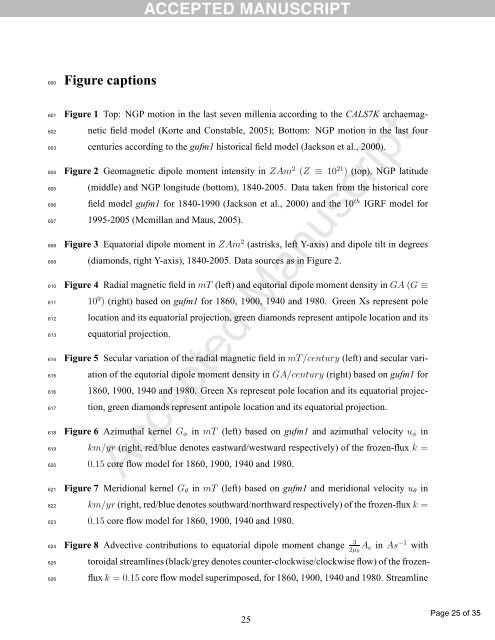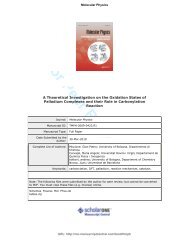Accepted Manuscript - TARA
Accepted Manuscript - TARA
Accepted Manuscript - TARA
You also want an ePaper? Increase the reach of your titles
YUMPU automatically turns print PDFs into web optimized ePapers that Google loves.
600<br />
Figure captions<br />
601<br />
602<br />
603<br />
604<br />
605<br />
606<br />
607<br />
608<br />
609<br />
610<br />
611<br />
612<br />
613<br />
614<br />
615<br />
616<br />
617<br />
618<br />
619<br />
620<br />
621<br />
622<br />
623<br />
Figure 1 Top: NGP motion in the last seven millenia according to the CALS7K archaemag-<br />
netic field model (Korte and Constable, 2005); Bottom: NGP motion in the last four<br />
centuries according to the gufm1 historical field model (Jackson et al., 2000).<br />
Figure 2 Geomagnetic dipole moment intensity in ZAm 2 (Z ≡ 10 21 ) (top), NGP latitude<br />
(middle) and NGP longitude (bottom), 1840-2005. Data taken from the historical core<br />
field model gufm1 for 1840-1990 (Jackson et al., 2000) and the 10 th IGRF model for<br />
1995-2005 (Mcmillan and Maus, 2005).<br />
Figure 3 Equatorial dipole moment in ZAm 2 (astrisks, left Y-axis) and dipole tilt in degrees<br />
(diamonds, right Y-axis), 1840-2005. Data sources as in Figure 2.<br />
Figure 4 Radial magnetic field in mT (left) and equtorial dipole moment density in GA (G ≡<br />
10 9 ) (right) based on gufm1 for 1860, 1900, 1940 and 1980. Green Xs represent pole<br />
location and its equatorial projection, green diamonds represent antipole location and its<br />
equatorial projection.<br />
Figure 5 Secular variation of the radial magnetic field in mT/century (left) and secular variation<br />
of the equtorial dipole moment density in GA/century (right) based on gufm1 for<br />
1860, 1900, 1940 and 1980. Green Xs represent pole location and its equatorial projection,<br />
green diamonds represent antipole location and its equatorial projection.<br />
Figure 6 Azimuthal kernel G φ in mT (left) based on gufm1 and azimuthal velocity u φ in<br />
km/yr (right, red/blue denotes eastward/westward respectively) of the frozen-flux k =<br />
<strong>Accepted</strong> <strong>Manuscript</strong><br />
0.15 core flow model for 1860, 1900, 1940 and 1980.<br />
Figure 7 Meridional kernel G θ in mT (left) based on gufm1 and meridional velocity u θ in<br />
km/yr (right, red/blue denotes southward/northward respectively) of the frozen-flux k =<br />
0.15 core flow model for 1860, 1900, 1940 and 1980.<br />
624<br />
625<br />
626<br />
Figure 8 Advective contributions to equatorial dipole moment change 3<br />
2µ 0<br />
A e in As −1 with<br />
toroidal streamlines (black/grey denotes counter-clockwise/clockwise flow) of the frozen-<br />
flux k = 0.15 core flow model superimposed, for 1860, 1900, 1940 and 1980. Streamline<br />
25<br />
Page 25 of 35
















